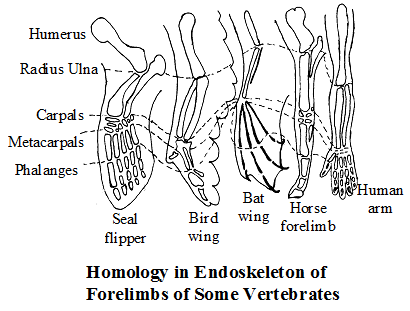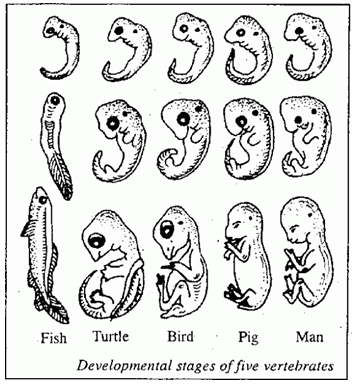What are the Four Types of Evidence for Evolution
Homologus Organs :
- These organs are similar in structure but disimilar in functions.
- Homologous organs are found in forms showing adaptive radiation from a common ancestor so these give evidence of ‘divergent evolution’.
- Ex. forelimbs of mammals, bat’s wing, a cat’s paw.
- In plants homologous organs may be a thorn or a tendril as they arise in the axillary position. If homology is seen at the molecular level. This is called molecular homology.

Analogous Organs :
- These organs are perform similar function but quite different in origin and development.
- Analogous organs are also called homoplastic organs.
- Analogous organs like wings of insects, birds and bats illustrate ‘convergent evolution’.
- Ex. – Wings of birds, wings of insects show the same function but their origin and development is different.
Vestigial Organs :
- Vestigial organs are useless organs found in the body. These are present in reduced form.
- Ex. wings of kiwi, limbs of snakes, the nictitating membrane of the eye, body hair and the muscles that move the ears.
- During the period of evolution vestigial organs have become functionless.
Fossil Evidences :
- Fossils are the remains of the organisms that found in the ancient period. We can determine fossil’s age through the period of rock by radioactive material. Histological time scale is a chronological order of evolution history based upon the study of fossils.
- Study of fossils known as palaeontology.
Petrification :
- Hard parts are preserved in this type of fossil.
Archaeopteryx :
- A fossil bird show both reptilian and avian features – It had wing like birds, thecodent dentition and tail like reptiles. Hence, archeopteryx is a connecting link between birds and reptiles.
Connecting links :
Peripatus | Arthopods and annelids |
Neopilina | Annelids and molluscans |
Protopterus | Amphibians and fishes |
Viruses | Living and nonliving |
Euglena | Plants and animals |
| Platypus | Reptiles and Mammals |
Embryological Evidences:
The study of embryo from variours organisms reveals similarity in the early stages of embryo development & this theory suggests that these organism have evolved from common ancestors.
Eg. Embryos of fish, turtle, bird, pig & man shows the similarity during embryo development.

